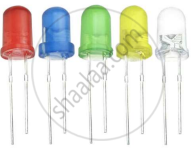Advertisements
Advertisements
प्रश्न
Briefly explain its working. Draw its V - I characteristics for two different intensities of illumination ?
उत्तर
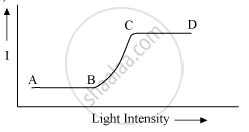
-
Current AB that flows when no light is incident is called dark current.
-
When photons of light having energy hν fall on the photodiode, more electrons from the valence band move to the conduction band, provided hv is greater than the forbidden energy gap.
-
The current in the circuit increases. As the intensity of light is increased, the current goes on increasing (represented by the part BC).
- When the current does not increase with the increase in intensity of light, the photodiode is said to be saturated. The portion CD of the graph represents the saturated current.
V-I characteristics:

संबंधित प्रश्न
Meeta's father was driving her to school. At the traffic signal, she noticed that each traffic light was made of many tiny lights instead of a single bulb. When Meeta asked this question to her father, he explained the reason for this.
Answer the following questions based on above information:
(i) What were the values displayed by Meeta and her father?
(ii) What answer did Meeta's father give?
(iii) What are the tiny lights in traffic signals called and how do these operate?
Using the necessary circuit diagrams, show how the V-I characteristics of a p-n junction are obtained in
Forward biasing
How are these characteristics made use of in rectification?
A p-n photodiode is fabricated from a semiconductor with band gap of 2.8 eV. Can it detect a wavelength of 6000 nm?
Sunil and his parents were travelling to their village in their car. On the way his mother noticed some grey coloured panels installed on the roof of a low building. She enquired from Sunil what those panels were and Sunil told his mother that those were solar panels.
(a) What were the values displayed by Sunil and his mother? State one value for each.
(b) In what way would the use of solar panels prove to be very useful?
(c) Name the semiconductor device used in solar panels. Briefly explain with the help of a diagram, how this device works
Show the output waveforms (Y) for the following inputs A and B of (i) OR gate (ii) NAND gate ?
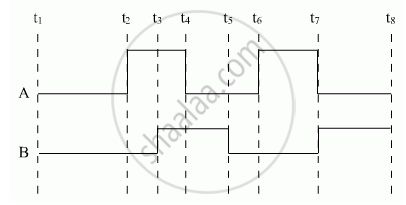
What happens to the width of depletion player of a p-n junction when it is (i) forward biased, (ii) reverse biased?
What is the magnitude of the potential barrier across a Ge p-n junction?
Which one of the following is not the advantage of LED?
If the resistance R1 is increased (Figure), how will the readings of the ammeter and voltmeter change?
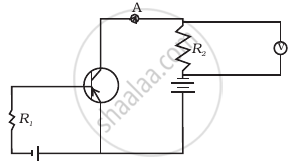
Read the following paragraph and answer the questions.
|
LED is a heavily doped P-N junction which under forward bias emits spontaneous radiation. When it is forward-biased, due to recombination of holes and electrons at the junction, energy is released in the form of photons. In the case of Si and Ge diode, the energy released in recombination lies in the infrared region. LEDs that can emit red, yellow, orange, green and blue light are commercially available. The semiconductor used for fabrication of visible LEDs must at least have a band gap of 1.8 eV. The compound semiconductor Gallium Arsenide – Phosphide is used for making LEDs of different colours.
|
- Why are LEDs made of compound semiconductor and not of elemental semiconductors?
- What should be the order of bandgap of an LED, if it is required to emit light in the visible range?
- A student connects the blue coloured LED as shown in the figure. The LED did not glow when switch S is closed. Explain why?
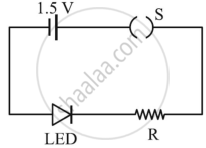
OR
iii. Draw V-I characteristic of a p-n junction diode in
(i) forward bias and (ii) reverse bias
